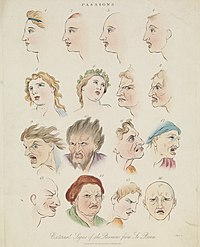
Pain modulates early sensory brain responses to task-irrelevant emotional faces.
Sign Up to like & getrecommendations! Published in 2023 at "European journal of pain"
DOI: 10.1002/ejp.2097
Abstract: BACKGROUND Pain can have a significant impact on an individual's life, as it has both cognitive and affective consequences. However, our understanding of how pain affects social cognition is limited. Previous studies have shown that… read more here.
Keywords: happy faces; modulates early; emotional faces; pain ... See more keywords

Modulating adaptation to emotional faces by spatial frequency filtering
Sign Up to like & getrecommendations! Published in 2018 at "Psychological Research"
DOI: 10.1007/s00426-016-0830-x
Abstract: In four experiments, we investigated the presence and strength of perceptual aftereffects to emotional faces, using spatial frequency filtering to manipulate awareness of emotional content. We presented angry and happy faces as adapters and used… read more here.
Keywords: control; frequency filtering; spatial frequency; emotional faces ... See more keywords

Emotional faces influence evaluation of natural and transformed food
Sign Up to like & getrecommendations! Published in 2018 at "Psychological Research"
DOI: 10.1007/s00426-017-0857-7
Abstract: Previous evidence showed the presence of a straight relationship between feeding behavior and emotions. Despite that, no studies have focused on the influence of emotional faces on food processing. In our study, participants were presented… read more here.
Keywords: emotional faces; evaluation natural; natural transformed; influence ... See more keywords

Resting heart rate variability is negatively associated with mirror neuron and limbic response to emotional faces
Sign Up to like & getrecommendations! Published in 2019 at "Biological Psychology"
DOI: 10.1016/j.biopsycho.2019.107717
Abstract: Whether neurovisceral integration, reflected by resting high-frequency heart rate variability (HRV), constrains or facilitates neural reactivity to other people's emotions is unclear. We assessed the relation between resting HRV and neural activation when observing and… read more here.
Keywords: resting hrv; emotional faces; mirror neuron; heart rate ... See more keywords

Target meta-awareness is a necessary condition for physiological responses to masked emotional faces: Evidence from combined skin conductance and heart rate assessment
Sign Up to like & getrecommendations! Published in 2018 at "Consciousness and Cognition"
DOI: 10.1016/j.concog.2017.10.013
Abstract: Much heated debate surrounds the extent to which we can process emotional stimuli without awareness. In particular the extent to which masked emotional faces can elicit changes in physiology measurements, such as heart rate and… read more here.
Keywords: target meta; physiological responses; masked emotional; emotional faces ... See more keywords

Attending to emotional faces in the flanker task: Probably much less automatic than previously assumed.
Sign Up to like & getrecommendations! Published in 2018 at "Emotion"
DOI: 10.1037/emo0000538
Abstract: Attention to emotional faces was tested in a series of 5 experiments using the flanker paradigm. Distraction and compatibility effects that were stronger for emotional compared to neutral faces were found in only one of… read more here.
Keywords: task; attending emotional; faces flanker; emotional faces ... See more keywords

Hindsight bias for emotional faces.
Sign Up to like & getrecommendations! Published in 2022 at "Emotion"
DOI: 10.1037/emo0001068
Abstract: People who learn the outcome to a situation or problem tend to overestimate what was known in the past-this is hindsight bias. Whereas previous research has revealed robust hindsight bias in the visual domain, little… read more here.
Keywords: bias emotional; emotional faces; emotion; hindsight bias ... See more keywords

Cross-cultural applicability of eye-tracking in assessing attention to emotional faces in preschool-aged children.
Sign Up to like & getrecommendations! Published in 2022 at "Emotion"
DOI: 10.1037/emo0001124
Abstract: Humans show an attention bias toward emotional versus neutral information, which is considered an adaptive pattern of information processing. Deviations from this pattern have been observed in children with socially withdrawn behaviors, with most research… read more here.
Keywords: eye tracking; emotional faces; cultural applicability; cross cultural ... See more keywords

Specific and segregated changes to the functional connectome evoked by the processing of emotional faces: A task-based connectome study
Sign Up to like & getrecommendations! Published in 2020 at "Scientific Reports"
DOI: 10.1038/s41598-020-61522-0
Abstract: The functional connectome is organized into several separable intrinsic connectivity networks (ICNs) that are thought to be the building blocks of the mind. However, it is currently not well understood how these networks are engaged… read more here.
Keywords: connectome; connectivity; study; functional connectome ... See more keywords

Examination of the neural basis of psychotic-like experiences in adolescence during processing of emotional faces
Sign Up to like & getrecommendations! Published in 2020 at "Scientific Reports"
DOI: 10.1038/s41598-020-62026-7
Abstract: Contemporary theories propose that dysregulation of emotional perception is involved in the aetiology of psychosis. 298 healthy adolescents were assessed at age 14- and 19-years using fMRI while performing a facial emotion task. Psychotic-like experiences… read more here.
Keywords: response; age; like experiences; psychotic like ... See more keywords

More than meets the heart: systolic amplification of different emotional faces is task dependent
Sign Up to like & getrecommendations! Published in 2020 at "Cognition and Emotion"
DOI: 10.1080/02699931.2020.1832050
Abstract: ABSTRACT Interoceptive processes emanating from baroreceptor signals support emotional functioning. Previous research suggests a unique link to fear: fearful faces, presented in synchrony with systolic baroreceptor firing draw more attention and are rated as more… read more here.
Keywords: task; heart systolic; fearful faces; visual search ... See more keywords